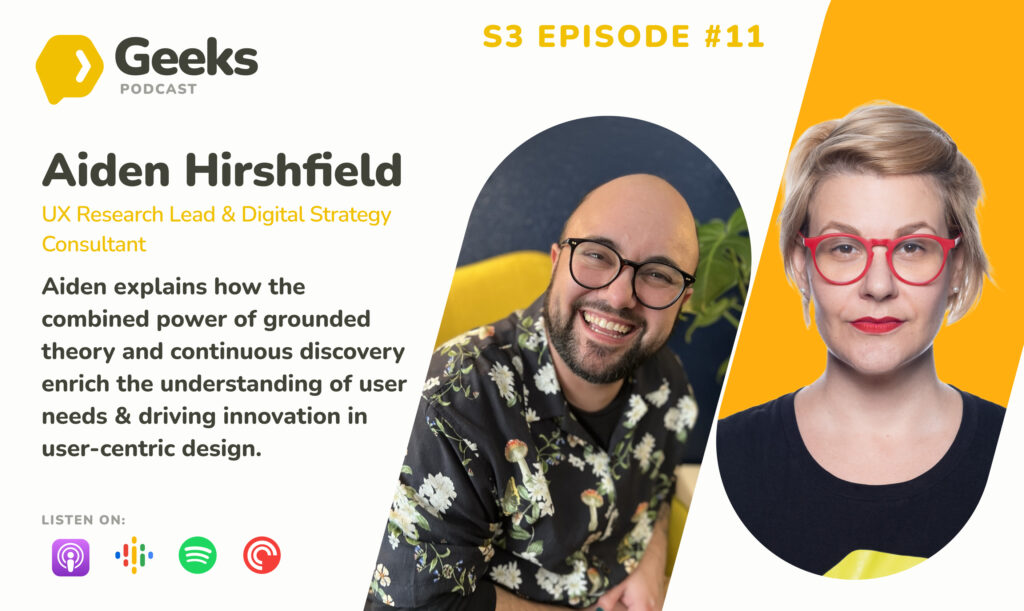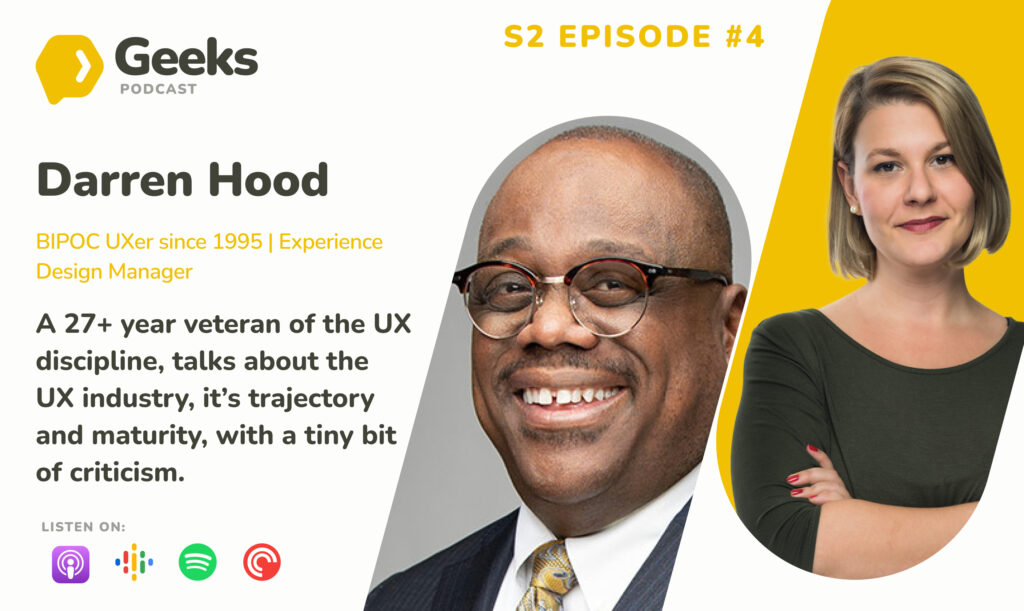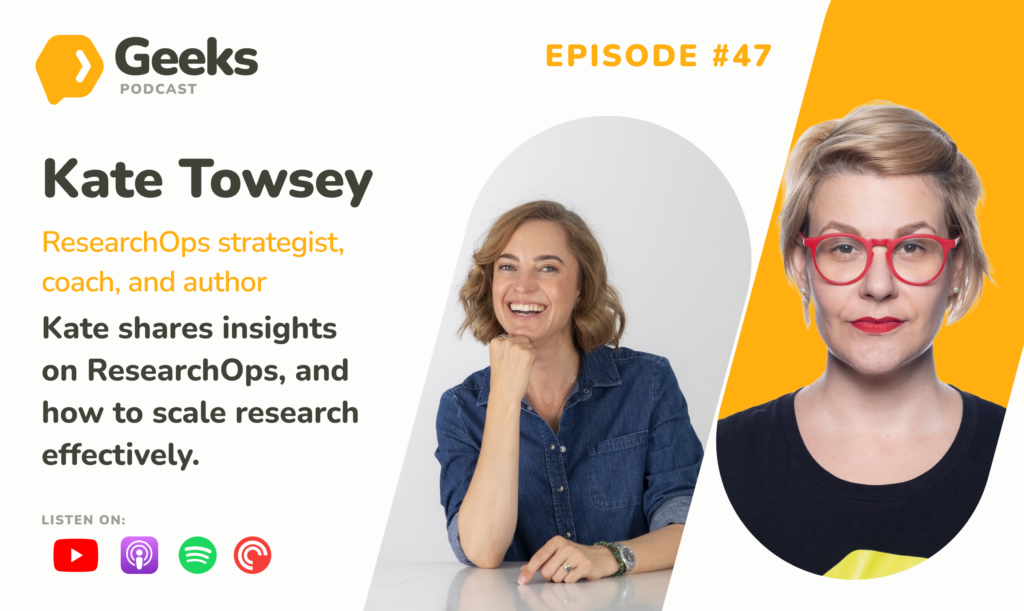🐝 The UXtweak team apologizes for the sound quality and wishes you a pleasant listening experience.
Episode highlights
- 00:03:39 – Workshop at uxcon vienna
- 00:07:01 – Concept of Deep Listening
- 00:20:12 – Affinity Techniques and Patterns
- 00:29:30 – Creating a Safe Space for Dialogue
- 00:37:43 – Reflecting on Economic and Social Challenges
About our guest Indi Young
Indi is a qualitative data scientist who makes tools that support inclusive and responsible solutions for a broader variety of thinking styles. She teaches courses online, writes books & essays, presents talks and does podcast appearances, and pens helpful posts on LinkedIn.
About uxcon vienna
uxcon vienna is a conference dedicated to UX Research and UX Design. It brings together professionals, experts, and enthusiasts in the field of UX to share knowledge, insights, and best practices. The conference is attended by both specialists from both Europe and the US, thus providing a great opportunity for networking or professional exchange. Attendees can expect to learn about the latest trends and developments in UX research and design, gain practical skills, and connect with like-minded individuals. uxcon vienna aims to inspire and empower UX professionals to create impactful user experiences.
Podcast transcript
[00:00:00] Tina Ličková:
This is the 37th episode of UXR Geeks and the first of four special episodes for uxcon vienna 2024. The conference takes place in September at Expedithalle in Vienna, Austria, featuring speakers like Vitaly Friedman, Nikki Anderson, Anfisa Bogomolova or Steve Portigal and Indi Young.
In this episode, I’m talking to Indi, who is well known for her work on thinking styles, mental models, skyline and inclusive product strategy in general. Indi will be conducting a full-day workshop on “Listening Deeply” on September 18th, which is a warm-up day at the uxcon vienna. You are very much invited.
We have been discussing deep listening and understanding user cognition, offering quite practical techniques to uncover users’ underlying thoughts and emotions.
I am wondering what is new in the Indi world?
[00:01:18] Indi Young: Hmm. I have a big new thing in the Indi world. Things that I keep hearing from people in my courses and in the research that I do and everything. People are like, how do I persuade my manager to do this awesome kind of research because the value is so high. I see it, but they don’t.
And so for the past six months, I’ve dived deeply into that. I’ve added to my meta mental model skyline, which is about how people sell in mental models. And the work that I’ve done, I’ve been Working with both the community and a whole bunch of people who would buy or would buy into this mindset, this idea that there is some valuable knowledge that you could use, and it lasts for years, and it’s going to help you.
I started out not knowing How I know how to talk to other researchers. One of the researchers said, we just need an elevator pitch. And I’m like, yeah, we do. So I hired a coach. I hired these people. I went and talked to a whole ton of people. We’ve done a bunch of work learning what are the things, and we boiled it down to six different values, uh, that would be of use to someone.
We also figured out that it’s really for people who are having some sort of say in the direction of either a product line or an organization, the strategy direction kind of thing. And. It is for organizations that support a large audience. If your audience is just like very specifically a certain kind of physician that does a certain kind of surgery, a certain kind of way, then maybe you don’t need this kind of research, or maybe you do, because even within one role, people think about it differently.
And it’s fun to see that I’ve done that kind of research before. And it was with a data center managers and there are people who hired me. They’re all like, wow. Whoa, I did not realize that people thought about their jobs so differently.
[00:03:39] Tina Ličková: I have a duty to my friends from uxcon, to Andrés and Nicole, who I’m greeting with this line. And you are going to be at uxcon vienna and giving a workshop.
[00:03:49] Indi Young: Yes.
[00:03:49] Tina Ličková: Just very shortly, what is this workshop about? And then we’ll dive in.
[00:03:54] Indi Young: This is a new workshop. I cut when I took time off to really ramp up the courses.
I’m like, I had no more workshops because all these managers would come and say, just make it simple. Teach them everything in one day. And I would spend a half an hour telling them it’s not simple. And finally they’d come around. They’re like, Oh yeah, it’s not simple. So I made the courses. So that. There is a simple way to take in this incredible mindset shift and have it settle into your mind in a way that really works.
So the workshop is new. We’re past COVID. I can do something in person and knock on wood past COVID. I can do something in person. And, um, What I can do doesn’t have to be teaching everything. What it can be is an intro to some of the concepts and lots and lots of practice. So the practice that we do is super fun.
It’s going to be a whole day of that. We’re going to learn a lot about each other that we never knew because the workshops about listening deeply. And it’s also about why. A lot of the time when we’re talking to our managers, they’re like, well, it sounds really lovely, but we’re not a psychology organization.
And so why would we need to know people’s interior cognition? So part of the workshop is going to talk about why, what do we do with this? Why is because we’re going to be able to see patterns. Across people in a whole new way in an unexpected way, which allows us to then for 1 understand that we have markets within our markets.
We have cracks in our audience where people are falling through. And if we. Figure out how to support those cracks. We’ve added 10 percent again to our market. Easy. But we’re not aware of those things now without doing this kind of research. Another thing is that people say, let’s go innovate and innovation requires.
Knowledge. And with that comes the openness to embrace the idea that if we understand our audience better, we’re going to see a whole lot more taking off points for where we want to go with some innovation. The thing we haven’t unveiled yet is that my partner of many years doing this kind of research, Lad Decker is also going to join us and she works Link UX in Seattle, and she has a ton of application stories that are different than my application stories.
So great. She and I are going to be like, have no voice left at the end of the day, like we will be telling stories all the time. It will be awesome.
[00:07:01] Tina Ličková: We have an audience, which we probably don’t on listening or listening deeply, but I was mentioning before we started to record that I grew up in the tradition of what is called active listening and everybody’s defining it differently.
And that’s where I was like, okay, but what the really means. This listening deeply, could you explain it to me?
[00:07:24] Indi Young: There’s a lot of different definitions for listening, for active listening. I like to define this more as the term called non directed listening. My background has always been plied. I’ve never been an academic, the school I went to, the schools plural I went to were both applied.
And so I look at the tools around me and I figure out how to mess with them or invent something new that adds to them to make what I need come out of it. And so that is. What I have turns out to be non directed interview style. It is also coming with a set of guidelines, a set of types of things that you can ask session or get at somebody’s interior cognition.
Interior cognition is not somebody’s opinion. It’s not somebody’s preference. It’s not somebody’s explanation why something is done this way or explanation of the process or statements of fact. It is their inner thinking. It is some emotional reactions. It is the personal rules or guiding principles they use to make decisions.
But what we do is we cast it all in the past. We’re not doing a ride along. Oh, what’s going through your mind now? Often very difficult for people to figure out what it is that’s going through your mind right now. And then communicate it to somebody who’s like this nosy stranger sitting next to you. You would have to be doing meditation sessions before.
Great idea. So what, what I do is I have a special way of framing is framed by a certain thing that the person’s trying to address in the past, we’re only going to talk about what went through their mind. That’s easier. The other thing that I do is that’s different is that I do an intro session with everybody.
The intro session comes before the listening session. It sets the stage. It makes sure that they’re comfortable with this. Cause this is not a question and answer kind of interview. It’s a chat. It’s a discovery. It’s an exploration that one of the analogies I use is that the person who’s doing the storytelling is taking you on a tour of.
Maybe their favorite, uh, hike, or maybe their garden, maybe their city, they’re taking you on a tour and you’re following them and you’re not allowed to ask about anything that they haven’t brought up. Very simple. One of the things though, that I mentioned earlier about pull tabs is that since we’re after interior cognition, and there’s a reason why, and that’s part of the workshop, because we’re after interior cognition.
We have to sense where we’re getting it and where we’re not getting it. And if we sense that there’s something someone was saying. If we didn’t get to their inner thinking about it, we’ll ask a question about it. And the question might come in a various format, it might be a micro reflection. It might be a, tell me what went through your mind.
It might be pin it to a place in time. It might be find the roots. Tell me where that came from, where, where did that come from? And those are the ways, those are some of the ways that we use to get back to what went through their mind at that point in time.
[00:10:55] Tina Ličková: You were mentioning getting inspiration from psychologists, and I love the expression psychologists are using the open door and in a discussion you have more open doors.
Sometimes it’s really hard to decide which one do you take and because it turns the discussion into different type of rules. On the other hand, I am wondering, and this is something again coming from therapy. If my therapist. takes, decides to open the door with me and I start to speak, she sometimes tells me to go back to not looking for the why and not going into analysis, but to try to feel.
But we are researchers, we are not doing therapeutics. We’re not doing therapy. Although we sometimes want to think we do it. No. How do you make sure that they don’t go into wild hypothesizing and stuff like that?
[00:11:49] Indi Young: The purpose, the frame of a therapy session is to help you learn something about yourself so that you can achieve something you want.
Mostly internal. Purpose of a listening session is to understand what went through someone’s mind as they were trying to address something. That’s something that they were trying to address has some relationship to what your org does in terms of its solutions. So, by using that frame, it keeps it from going into, like, self analysis land.
Right by using that frame, what we get to do is we get to understand where, like, I, I might, you called it opening a door. I think a pull tab slightly different. It could be maybe the same, but what, what we’re doing is we’re letting people tell us what went through my mind there. And that’s connected to what it went through my mind there.
And that’s connected to this. And we let go. And I have a whole. I have a whole video in my course about listening deeply about choosing which pull tab and there, and it really doesn’t matter because they’re showing you around their favorite hike. They’re showing you around their garden, there are boundaries to it.
We will explore it all. At their pace until we feel like we got to the center of everything that they brought up and they’re done bringing things up. So, even if we choose 1 poll tab, and not another poll tab yesterday in our practice group, there was 1 question. It was just like, um. It, it opened something up for the storyteller and there were like eight pull tabs right there.
Yeah. And we got to discuss it and they’re all like, Oh, I would’ve pulled that pull tab. I would’ve pulled that one. Didn’t matter which one you pulled because during the course of a listening session, you’ll get back to all of them.
[00:13:49] Tina Ličková: I don’t know how to ask this question, but it’s an interesting thought.
Like, can you hear us?
[00:13:54] Indi Young: Yeah, you can trust it. And part of it is you can trust the person. The person is aware of the boundaries. The person is also aware of their own sense of safety and we need To recognize their sense of safety at some point, they are going to get tired and not want to talk about a topic anymore or not want to be in a listening session anymore.
And we have to notice that usually with a listening session. I don’t ever end it. It doesn’t end after an hour or half an hour, it ends when the person is done bringing up topics and I feel like I’ve gotten to the center of each of those topics, the interior cognition of each of those topics. So that’s actually another difference between therapy.
You’re trying to get to the center of the person with this. I use this analogy of a little jawbreaker, this little candy. Okay, and the candy has the layers and you want to get to the center of each of those layers But each candy is a topic. The person is not a candy You’re not trying to crack the person to get to the center.
You’re just trying to crack the topic. And so this is in a whole different relationship to that person. Now we’re like both of us sitting on the same side of the table, looking at all of those candies that they’re putting out there, all of those topics that they’re putting out there. And we’re both just exploring them.
We both get excited about it. Oftentimes people will say, God, I discovered something new about my Or that question you asked made me realize oftentimes we get people at the end of this saying, I have never been felt so heard before.
[00:15:42] Tina Ličková: Okay, but the metaphor or bringing up the example, I’ll probably. A little bit to the point when I hear this get it, but it would really strike my attention was and mentioning the meditation before is that you’re looking on to exploring and knowing the mind of the person and they knowing their mind.
And it’s not so much in the behavior. If I understand it. Am I right? Or would you say, Oh no, Tina, you misunderstood. You define behavior in your mind. Good question. That my mind could somehow rationalize my behavior and even do switch some reality, what I did or what I’m about to do into, and I would tell you something else that actually happened.
[00:16:29] Indi Young: No, we trust. Yeah. We’re going to trust the person to tell us what went through their mind. And there’s going to be places where they don’t remember. But since this is just about what went through your mind, what went through your heart, it’s really hard to, like, misremember. It’s easy to forget, but that’s fine.
We just moved to different, a different topic or a different time. So, if I was listening to somebody who was deciding to change how they exercise, because I’m an organization that wants to help in some respect with some part of that. Maybe I’m a shoe company, and I want to understand what it’s like when somebody’s changing from needing one kind of shoes for one kind of exercise to another kind of shoes for another kind of exercise, but we scope it differently.
It isn’t. Okay. How did you buy this? The thing is, no, let’s scope it by how did you decide to change? Your exercise. There was a study I did for a gaming company that wanted to have a game that helped build self confidence in a person’s own identity. And so what we did was we went and talked to a bunch of people who did personal identity change.
Okay. So there’s that linkage and this is a huge, that’s actually a whole other course that I teach is like, how do you figure out that linkage? Okay. So with the exercise thing, changing the way that you exercise is going to bring up, okay, there’s that time that I changed from, from going to the pool to running instead.
But there’s so many different things connected to it, because there might be something the person brings up is, I figured I should go back to running. And you’re like, okay, Back to running, there’s going to be something there and let’s see what they bring up. I’m not interrupting them and they bring up nothing related to the backup back to running.
But this hint that there was a time where they didn’t do any exercise at all. That’s an interesting pull tab. If they are done with that topic, I might ask more about the topic than some things they brought up, or I might go and say, so there was a time that you didn’t exercise at all. That is my prompt.
I don’t ask a question about it. They’ll tell me a story. Or not. They’ll remember. Or not. Probably they’ll remember that time where they didn’t and then they changed and they started. That would be very interesting for my organization to know about. But it’s all just went went through their mind. So I’m not, I’m not saying, okay, so we’re buying these shoes.
It is not quite as evaluative like that. It isn’t, it’s a, it is a type of generative research. However, it goes far beyond that. Further earlier, it is more about what’s the whole landscape. What’s the whole landscape that people are in? What are the patterns across them? And the patterns aren’t that these people bought this shoe this way, and those people spent 30 days buying the shoe.
Instead, the patterns are a person’s focus of mental attention. That’s very different. So, affinities, when you’re taught to do data synthesis, you said, okay, and now’s the time for you to put things together based on affinity. Does anybody tell you that there are 3 or 4 or 5 affinity techniques?
[00:20:12] Tina Ličková: Now I give a very big announcement to the world. Every time I hear from about affinity, I’m like, because I even tried to Google it, but it never actually made sense to me because you can approach it differently. But it’s always my mind somehow works it out and I can’t really label it. I know you start coding, you have different approaches and you, then you want to put it into a diagram.
[00:20:38] Indi Young: The whole, I think the whole problem with that is that affinity techniques aren’t really well known. And also my point is to represent people’s Thinking exists not as categorized by a researcher. So, when we go and code, even if we’re trying to do thematic and the codes are coming from the transcripts themselves going to be influenced by us.
It’s going to be influenced by our context at work. If we’re doing it instead, based on the person’s focus of mental attention, then we’re going to see some different patterns. And those patterns are going to be true to those people. So let me give you an example. If we were an insurance company or something, and we were curious about people’s thinking as they were in a near miss accident.
That’s like sort of the point, but apparently it extends in both directions around that point in time. And people have a lot of thinking. One of the things is that when you do these kinds of listening sessions, people are going to have completely different near miss accidents. Some of them are going to be in cars.
Some of them are going to be swimming or running, right? Some of them are going to be just walking down the street. There are a lot of different kinds of near miss accidents and you can’t put them together by the kind of accident or the stage, right? Okay, here’s before the accident. Here’s during the accident.
Here’s after the accident because it’s all tangled up. One of the, one of the interesting things that came out of that study is that people will latch on either during, before or after this accident to the idea of never letting that thing happen. Don’t want that to ever happen to me, or it could be my focus is I don’t want this to happen to other people.
There’s also this focus of I’m going to make a change or I’m going to ask an authority to make a change. It’s their focus of mental attention. It’s not ours. It’s not what we’re trying to like code it by. What we’re doing is we’re pulling those concepts out of the transcript. The concepts, the first part is just, okay, is that inner thinking?
Is that an emotional reaction? Is that a personal rule or guiding principle? I’m just going to pull those pieces out. They’re, they’re puzzle pieces. I’m going to, I’m going to summarize them so that they are nice and neat. Okay. It’s a certain formal formula that I use for the summaries and then we do the affinities.
Then we do affinity by focus of mental attention. I’m holding up this little summary this little puzzle piece I’m going is anybody else have the oh, wait, what’s the focus of mental attention this one? I think they were focused on Making a big change so that this doesn’t happen to me again, and I remember there was this other story Where is it?
Oh, yeah, this person also was focused on making a big change So this never happens again We have their 1000, 2000, 5000 piece puzzles. Uh, but we love puzzles. And there’s only one way that they end up going together. There are periods, inflection points that happen at certain points where you’re like, wait a minute, oh, this all needs to break up because I thought we were thinking of that focus of mental attention, but now that these other puzzle pieces have come in, this, no, it’s like this and that.
It is a. It is an affinity technique where two different researchers, even different organizations, given the same puzzle pieces, will end up with the same way of putting it together, the same patterns.
[00:24:28] Tina Ličková: A few thoughts. First of all, when listening to you, and this is very well paraphrased, paraphrases are my, even an interpretation, if we go back to the therapy language, is that listening deeply is, now I will use you, it’s a thinking style.
You are actually giving people a new mental model around listening. Which amazes me. Secondly, I love that you already explained how we look at it from the affinity diagramming or categorizing, because I sometimes have to be very careful about not falling into categorizing very soon in my analysis, because my brain just loves categories, whatever.
Oh yeah. And all humans love categories. And then. It even pisses me off when I have to rethink it, but that’s what I, that’s where I know, okay, you are debiasing right now. But this thing that you said, it’s a conversation, and you also mentioned that you are not even asking questions, but you are also prompting people.
What are the other techniques that you maybe use and will be, people will be practicing in the workshop?
[00:25:39] Indi Young: Yeah, there’s. There, this book here, chapter six is, that’s all the techniques. That’s like most of the book.
[00:25:48] Tina Ličková: People probably won’t see it in the podcast.
[00:25:52] Indi Young: The book is time to listen. Does that look like about a fifth of the book or something?
And quick, once you understand that there’s pull tabs, once you let go and trust that you’re going to hear about things, you don’t have to guide anyone. Once you realize you’re not going to be making hypotheses about people as you’re doing the listening, you can just follow. That’s when you get to start focusing on these techniques, these prompts.
Yeah, some of them come out in question form, but they’re not set questions. They’re styles. Yesterday when I was doing a demo, one of these, I ended up saying as a replacement for, uh, What went through your mind and that means I would just say, and that means and the person because of the way that they were speaking, I adopt adapt this kind of to the things they’re saying, and the way that they’re telling me these things and it just worked.
This person loved to talk about certain things. In terms of meaning, and so I would adopt that word and that would be a replacement for the technique of what went through your mind. Right? There’s a technique that I mentioned earlier called pin to a place in time. There’s the so when it’s all in memory mode, right?
We’re trying to keep it in memory mode. Why? Because it’s easier for people to talk about what went through their mind as opposed to what is going through my mind. However, That’s also a land of generalizations. So for the whole summer, I was waking up early and I’m like, could you take me back to one day you remember in particular?
Mm hmm. It went through your mind that day. Oh, okay. They’ll think for a little bit and then there’s, there were, there was this one day when There was this bird that kept landing and then taking off and landing and taking off from the top of my front gate. And I’m like, what was that? It was early in the morning.
I’m sitting there. I decided to sit there. It was cold out. So I sat at the window. I’m like trying to figure out what the bird is doing. And it was just like really nice, slow way of waking my mind up. And I felt, I noticed myself feeling really calm and really, um, Meta aware of the fact that I’m sitting here trying to figure out this bird in it’s helping me get into the waking world in a way that I really enjoy.
Right? So there’s a particular day that didn’t that bird might have happened a couple of times, but that was a moment. That was a moment and maybe they won’t remember, maybe they’ll say, I can’t remember, but I know that several mornings, what I like to do is get outside, even if I just can go out onto the front garden or maybe take a walk or something, maybe even just sitting down outside, if I don’t feel too well, but being on the outside, it gives me this feeling that the world is waking up around me.
And there’s some hustle and bustle, maybe it’s human, maybe it’s animal, maybe it’s the sound of the wind and the trees, but it’s this, the world is waking up around me.
[00:29:14] Tina Ličková: I am wondering, you are going pretty deep with the listening and with the inquiries in the conversation, and it’s, Without being so much interrupted or without interruption from our side as researchers.
[00:29:30] Indi Young: Yeah, I’m not interrupting, but I’m connecting, I’m very present. I’m not this little robot in the corner that like says one thing, then lets you go. And then the storytellers, I’m feeling awkward here all by myself. I’m like right now, we’re chatting. I don’t interrupt though. I’ve interrupted you a couple of times on this already.
So I try not to do that in a listening session, but it’s more of a, I’m here to show you that you are not being judged. I want to show you that you’re being heard. I want to show you that I’m trying to create a safe space for you. And I’m sensing when you’re feeling awkward and I’m reacting to it. And maybe helping you through something, or maybe deciding giving you the choice to go in a different direction.
That kind of thing. So I’m very present. I’ve got a whole section where I call it. Bring your personality. So I have these demos of listening sessions where there are 3 or 4 of us doing listening sessions. Each of us are totally different. We bring our personalities. So my style of doing a listening session is very Indi in the demo.
Andrea’s style of doing it is very Andrea, but it’s just different for each person and you want that there. Otherwise, it feels, I don’t know. I want to describe it as metallic or robotic. It feels cold. The person feels left alone and to get deep. Oh, that’s really difficult to get deep with something that cold.
It feels good. Well, it feels like you’re being put under a microscope and that’s not what we’re doing.
[00:31:22] Tina Ličková: And I’m wondering how do you then make sure and I’m. Thinking now about the audience who sometimes writes me or people respond to an episode and they’re always, Oh, this was great. This was really practical.
How do you actually make sure you reach your goals and you can transfer those goals to your clients or people who assign it to you?
[00:31:43] Indi Young: The whole idea is not to go and dig up the gold for the, um, organization. Because then that’s treating a person as a resource that you’re taking things from. Instead, with the organization, we’re going to do this research when we want to support people.
Now, support is not a very capitalistic word, but I think capitalism is growing and shifting a little bit and recognizing the fact that. Like growing your market by 10 percent means seeing where the cracks are and supporting those people. So when you are an organization and you want this kind of knowledge so that you can grow your market that way, or so that you can innovate, there’s a couple of other values that, that are also in play here, like being able to have a strategy that lasts for a decade.
That you come back to over and over again. It’s like a, the skyline is like a skeleton that you layer other data on that. You layer your evaluative data on that. You layer your data on. You use it as a dashboard. The idea, though, is that the skyline, the mental model skyline. Which is decorated with layers and layers of other information, which is compared to your existing solutions so that we can look and see where there are gaps.
And as a team, we see it all together, and as a team, we hold this thing over many years, which allows us to make incremental progress, measure that progress, put that back on this. Mental model skyline, see the metrics, see how we’re doing and progress slowly as opposed to just trying to hold it in our head.
Oh, yeah, this is like our roadmap. The roadmap goes to 1 product. It doesn’t go across all your products. This skyline is about what people are trying to get done with respect to their. Goal their purpose, their intent, which could be much bigger than just I’m buying this set of sneakers or that set of sneakers, right?
Yeah. Your product roadmaps are going to be the sneakers, but it’s not the person. You need the person. You need the people. You need the focuses of mental attention to be able to have a strategy like that. So, the question then is that if you, if you have that mindset, if we build these mindsets at our orgs, first of all, it’s going to be better for us internally.
Maybe we have things to argue about in a much more productive way. And we’re always going to argue about things, but now we have more productive arguments because their arguments and support or interpretation of what we see people trying to focus on. And the other aspect of it is going to be great for people because our goal is not to take from them and use what we took to figure out how to make more profit.
It’s going to be to understand them and use that understanding to create more support. I did a recent post on LinkedIn, I’m on LinkedIn a lot, and then that sort of cascades into Twitter, Blue Sky, and Instagram, and the thing that I did was, it was, I had heard something that a Netflix VP had said that was really, like, obviously demographic assumption.
And he said, Hey, we’re going to have ads. We’re going to place ads for the people who can’t pay very much. So for the very low end cost thing, you still get access to everything, but you got to watch ads and people love ads. And I’m like, okay, wait a minute. Let’s go, let’s go back. So in this post, I go back.
I’m like, let’s look at this in terms of thinking styles, which is another way of looking at the data besides the mental model skyline and thinking styles. Uh, and I’ve done a lot of research about people and money and other people have too. And we’ve realized that there’s this thinking style. There’s one where it’s a game.
I want to get as much as I can for the lowest cost. But there’s another thinking style, which is I need to control things so that the costs don’t overwhelm me. You might think of this, I don’t know if you pay a water bill or a utility bill, and it’s winter time, but the utility costs, the gas costs have gone up because some giant country is trying to take over another country and the fuel is disrupted or whatever.
Okay, so what do you do turn down your thermostat? You put on more sweaters, maybe even turn it off at night or something. You’re controlling it. There’s this mindset. About controlling it that now for the streaming company to go and say, hey, for you people, here’s the low cost thing. Okay. Yeah. Maybe I could afford it.
Maybe I couldn’t. And so my control is only I buy it or I don’t have access to it. Or and in addition, we’re going to serve ads at you ads for things that you can’t afford trying to control your costs. So the advertisers are going to get set up for that with that half of the audience. The audience, this, this is a game I want to get as much as possible for the least, they’ll probably buy things.
But that VP was one of them, or even someone outside of that who would never sign up for the low cost thing. So why not offer a low cost thing where you get to control, like you get to control how many days a month you get to control maybe how many hours a week or something you can control that on a monthly basis.
[00:37:43] Tina Ličková: Feeling of control and power of your life.
And not the feeling. Like I’m watching Netflix and they put all of these advertisements onto me. And I have to persist because I want to watch Netflix, but this is annoying. And they’re basically showing me all the time that I don’t have the money to pay for it. Exactly.
[00:38:04] Indi Young: No, it doesn’t feel nice. It could even, you could have somebody that you know, or in your family that really went off the deep end and lost their house and all it could trigger you.
It could remind you of that person every time you see an ad. Uh, yeah. Why are you doing that to people? Where you could, you don’t even have to do much work to just offer an ad free version where people can control.
[00:38:33] Tina Ličková: Indi, is there anything that you want to say? Is there anything that you want to leave the audience and me with?
[00:38:40] Indi Young: I think that we, um, are in a strange time economically, our economies are doing some strange things, corporate. Behavior is very strange, laying people off. It feels like the politics are also very scary these days. And so it seems like it’s easy. Like we’re surrounded by all this darkness, right? I’m actually giving a hybrid talk with my friend, Maria Mishchenko, who lives in Ukraine, and she uses that word.
We’re surrounded by darkness and yet joyful things happen. And. Can I be joyful or should I feel guilty? And I think that’s what I want to leave us with is that, my God, we are such an amazing community. I take great joy in meeting people and working with them and learning what they’re facing in hearing what they’ve come up with.
People mess around with what I have and take little snippets of it and put it into what they’ve gotten. It’s amazing. It’s so cool. We’re a great community. Whether we’re laid off or not, we’re here. We’re not gone. We’ll still be here.
[00:40:04] Tina Ličková:
Thank you for listening to UX Research Geeks. If you liked this episode, don’t forget to share it with your friends, leave a review on your favorite podcast platform, and subscribe to stay updated when a new episode comes out.
💡 This podcast was brought to you by UXtweak, an all-in-one UX research tool.

















